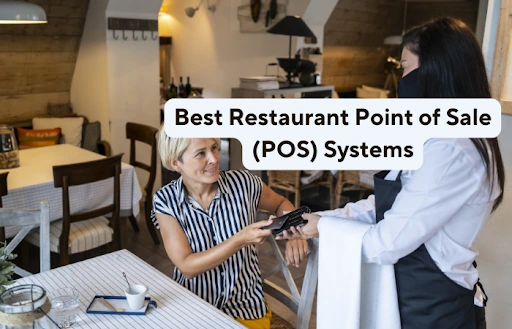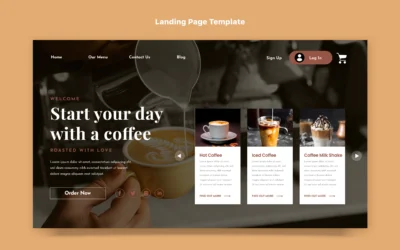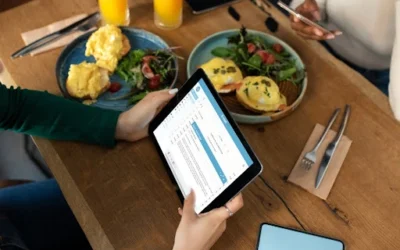Best Restaurant Point of Sale Software Recommended for 2024
Restaurant point-of-sale (POS) systems are a crucial aspect of any restaurant business, enabling owners to track sales, manage inventory and tables, and generate reports. A quality enterprise restaurant POS system can significantly impact profitability. With numerous options available, we evaluated them based on criteria such as ease of use, features, customer satisfaction, and third-party integrations. Following the assessment, we’ve selected and highlighted the top 10 systems below.
The 7 Top POS Systems for Restaurants
- Milagro: All-in-one Restaurant POS Software
- Toast: Ideal for contactless ordering
- Square: Optimal for small businesses
- Clover: Perfect for quick-service restaurants (QSRs)
- TouchBistro: or all-in-one restaurant management
- Revel: Ideal for iPad users
- SkyTab: Ideal for tableside restaurants
Why You Can Trust Milagro Advisor for Your Restaurant Business
You can trust Milagro Advisor for your restaurant business due to their expertise and experience in helping restaurant owners increase sales by up to $150k a year. Their recognized position in the industry and commitment to providing valuable guidance makes them a reliable source for restaurant business advice.
Milagro: All-in-One POS System – Best for All Restaurants
About
Milagro is an advanced multi-location restaurant and restaurant marketing automation software driven by AI. Distinguished by a thoughtful approach, Milagro’s best all-in-one POS system for restaurants is designed to enhance customer experiences and increase guest visits.
Milagro’s suite comprises SmartPOS, Wait List and reservations, Customer Experience Management, SmartMENUS, and Employee Scheduling. With a focus on seamless operations and enriched interactions, Milagro empowers businesses with intelligent tools for efficient management and elevated customer satisfaction. Experience the future of point-of-sale technology with Milagro’s innovative features and user-centric design.
Pros
- Valuable insights from customer-level metrics
- 3rd party delivery partners integration
- Table-side ordering and payment options are available
- Faster payment processing
Cons
- With a dedicated team of experts, Milagro explores every possibility.
Standout Features
- AI-powered marketing
- Multi-location support
Toast: Best for Contactless Ordering
About
Toast is an online restaurant platform that works for various types of restaurants, allowing customers to access digital menus and place orders through a QR code. It reduces contact between staff and customers for safety during the pandemic. Toast integrates with third-party services and offers a free plan, with paid plans starting at $69 per month.
Pros
- Free plan for restaurants
- Digital Ordering
Cons
- The free plan doesn’t include digital ordering
- API access is limited to custom plans
- No Customer Data Platform
Standout Features
- Cloud-based technology
- Advanced kitchen display system
Square: Best for Small Businesses
About
Square is a POS platform that offers a free basic plan for small restaurants, with advanced features and custom pricing for larger businesses. It provides tools and services such as payroll, loyalty programs, marketing, and team management. With 24/7 support, an online support center, and implementation services, Square provides ongoing support to help restaurants grow and succeed. It is accessible and easy to set up, making it an ideal solution for small businesses.
Pros
- Free to get started: You can try it out without any upfront costs.
- Easy to use: It’s designed to be user-friendly, even for those new to POS systems.
- Course meals included: Paid plans let you manage multi-course meals for smooth service.
Cons
- No tab pre-authorization: You can’t hold a card for open tabs (like bars often do).
- No Customer Data Platform
- No Wait List and Reservation App
- No Marketing Automation
- Not enterprise ready for multi-location restaurants
Standout Features
- Contactless payments
- Square Terminal for mobile
Clover: Best for Quick-Service Restaurants
About
Clover is a POS system designed for quick-service restaurants, offering features like shift management, table management, online ordering, and gift card processing. It also provides access to an app market for integration with third-party tools. The system facilitates easy ordering with color-coded menu items, and customers can pay using various methods while their orders queue up for the kitchen.
Pros
- Accepts mobile payments
- Loyalty program
- Built-in payment processing
Cons
- Its hardware is expensive
- No Customer Data Platform
- No Marketing Automation
- No Wait List and Reservation App
Standout Features
- EMV-ready hardware
- Contactless payments
TouchBistro: Best for Restaurant Management
About
TouchBistro is an all-in-one restaurant management solution that assists with inventory, menu engineering, guest tracking, and floor management. It includes a built-in CRM system for upselling and cross-selling to guests. The software integrates with popular third parties like QuickBooks, FreshBooks, Mailchimp, and Google Analytics. TouchBistro plans start at $69 per month, with additional services available as add-ons, such as loyalty programs, online ordering, gift cards, marketing, and reservations.
Pros
- Table management
- Manage takeout orders
- Tableside ordering
Cons
- Provides fewer integrations compared to some of its competitor’s
- Costs can add up quickly with additional features and integrations
Standout Features
- iOS-based POS technology
- QR code ordering
Revel: Idea for iPad Users
About
Revel is an iPad POS system, offering restaurant-specific features like online ordering, table management, drive-thru, delivery management, and multi-location management. Its open API allows for seamless integration with third parties. Revel plans start at $99 per month per terminal, with the requirement of ordering two terminals and signing a three-year contract. You need to fill out a quote form for pricing for just one terminal without lengthy contracts.
Pros
- Accept Apple Pay
- Manage multiple locations
- Streamline delivery management
Cons
- Costs for onboarding are comparatively high
Standout Features
- Cloud-based architecture
- Enterprise-level security features
SkyTab: Best for Tableside Restaurant
About
SkyTab offers a cost-effective and comprehensive point-of-sale solution for tableside restaurants, including free POS software and hardware, installation, and 24/7 support. The system eliminates the need for a large upfront investment and provides a lifetime hardware warranty, free paper supplies, and maintenance and service costs. The monthly pricing includes online ordering solutions, allowing restaurants to accept online orders through their branded website and integrate orders into the POS app. Credit card processing is also covered, with rates based on industry, average ticket, processing volume, and credit.
Pros
- Most competitively priced choices featured
- Free Installation
- Free hardware
Cons
- Variable processing fees
Standout Features
- Mobile payment solutions
- Integration
What Is a Restaurant POS System?
A restaurant POS system is software designed to assist restaurants in managing their business. It encompasses features such as inventory management, menu management, guest tracking, and floor management. Some restaurant POS systems may also incorporate built-in CRM systems to facilitate upselling and cross-selling to guests.
Benefits of a POS System
Using a cloud POS system for restaurants offers numerous benefits. It helps save time and money by automating tasks like inventory management and reporting, allowing staff to focus on more critical responsibilities. Additionally, the POS platform can boost sales through features like upselling and cross-selling, encouraging guests to spend more. Moreover, they improve customer service by providing guest tracking features, enabling staff to quickly access guest information and deliver better service.
How To Choose the Best Enterprise Restaurant POS System
When selecting the top restaurant POS software, it is essential to consider several factors. Firstly, it is crucial to assess the specific requirements of your restaurant, such as its size, cuisine, and number of locations.
Once you have identified your needs, you can evaluate the features of various POS systems, including online ordering, gift cards, loyalty programs, and table management.
Additionally, the cost of the POS software is a critical consideration, as some hardware systems can be quite expensive. Lastly, reading customer reviews can provide valuable insights into common issues or challenges with specific POS systems for restaurants, helping you make an informed decision.
Essential POS Hardware Features
- Touchscreen monitor: A clear and large touchscreen monitor for easy navigation
- Barcode scanner: Essential for quick item scanning and accurate inventory tracking
- Cash drawer: Important for securely storing cash and credit card receipts
- Receipt printer: High-speed printer for quick and accurate customer receipts
- Kitchen printer: Dedicated printer to streamline kitchen operations and ensure correct orders
- Credit card terminal: Secure terminal for processing customer payments
- Mobile POS: System allowing flexibility and tableside order and payment processing
- Customer display: Shows items being purchased and total cost to prevent mistakes and overall to build trust
Essential POS Software Features
1. Sales & Inventory Management:
- Seamless transactions: Process orders quickly and efficiently with various payment options.
- Inventory tracking: Monitor stock levels in real time to avoid stockouts and overstocking.
- Product management: Easily add, edit, and manage product information and pricing.
- Low-stock alerts: Get notified when inventory dips below predefined thresholds.
2. Customer Management:
- Customer profiles: Track customer purchase history and preferences for personalized offerings.
- Loyalty programs: Implement reward programs to build customer loyalty and repeat business.
- CRM integration: Sync customer data with your CRM for enhanced marketing and sales automation.
3. Reporting & Analytics:
- Sales reports: Track sales performance by day, week, month, or year.
- Profitability analysis: Gain insights into your business’s profitability and identify areas for improvement.
- Employee performance: Monitor individual and team performance based on sales data.
4. Operational Efficiency:
- Employee management: Schedule shifts, assign roles, and track employee performance.
- Table management: Optimize table utilization and seating arrangements for smooth service.
- Kitchen display system: Send orders directly to the kitchen for faster preparation
- Integrations: Connect with accounting software, delivery platforms, and other business tools.
5. Security & Compliance:
- Data encryption: Protect sensitive customer and financial data with secure encryption.
- PCI compliance: Ensure adherence to payment card industry security standards.
- Regular backups: Securely backup your data to prevent loss in case of technical issues.
A Guide to Restaurant POS Pricing Structures
Software Costs:
- Subscription fees: Monthly or annual recurring charges for the POS software itself.
- Per-transaction fees: Additional charges for each processed transaction, sometimes tiered based on the transaction amount.
- Setup fees: One-time fee for initial installation and configuration of the system.
- Training fees: Additional costs for in-person or online training for your staff.
Hardware Costs:
- POS terminal: The cost of the hardware itself, may be leased or purchased outright.
- Peripherals: Additional costs for printers, cash drawers, barcode scanners, tablets, etc.
- Internet connection: A reliable internet connection is crucial for POS functionality, considering fees and potential upgrades.
Payment Processing Fees:
- Credit card processing fees: Merchant account fees and per-transaction charges for accepting credit card payments.
- Third-party payment gateway fees: Additional fees for using a third-party payment gateway for processing transactions.
Other Potential Fees:
- Data storage fees: Some POS systems charge extra for storing your data in the cloud.
- Integrations: Costs for integrating the POS system with other software like accounting or delivery platforms.
- Support fees: Some providers offer optional premium support plans with quicker response times or after-hours support.
Tips for Selecting the Best Restaurant POS Pricing:
- Compare different providers: Get quotes from multiple POS vendors and compare their pricing structures.
- Estimate your usage: Calculate your expected transaction volume and choose a plan that fits your needs.
- Consider hidden fees: Ask about all potential fees upfront to avoid surprises down the line.
- Negotiate if possible: Avoid negotiating with POS providers for better deals, especially for long-term contracts.
Restaurant POS Systems vs. Traditional Cash Registers: A Head-to-Head Comparison
| Feature | Cash Register | POS System |
|---|---|---|
| Efficiency & Speed |
|
|
| Record-Keeping Accuracy |
|
|
| Scalability & Growth |
|
|
| Customer Experience |
|
|
| Data Insights & Reporting |
|
|
| Security & Compliance |
|
|
| Additional Features |
|
|
| Cost |
|
|





